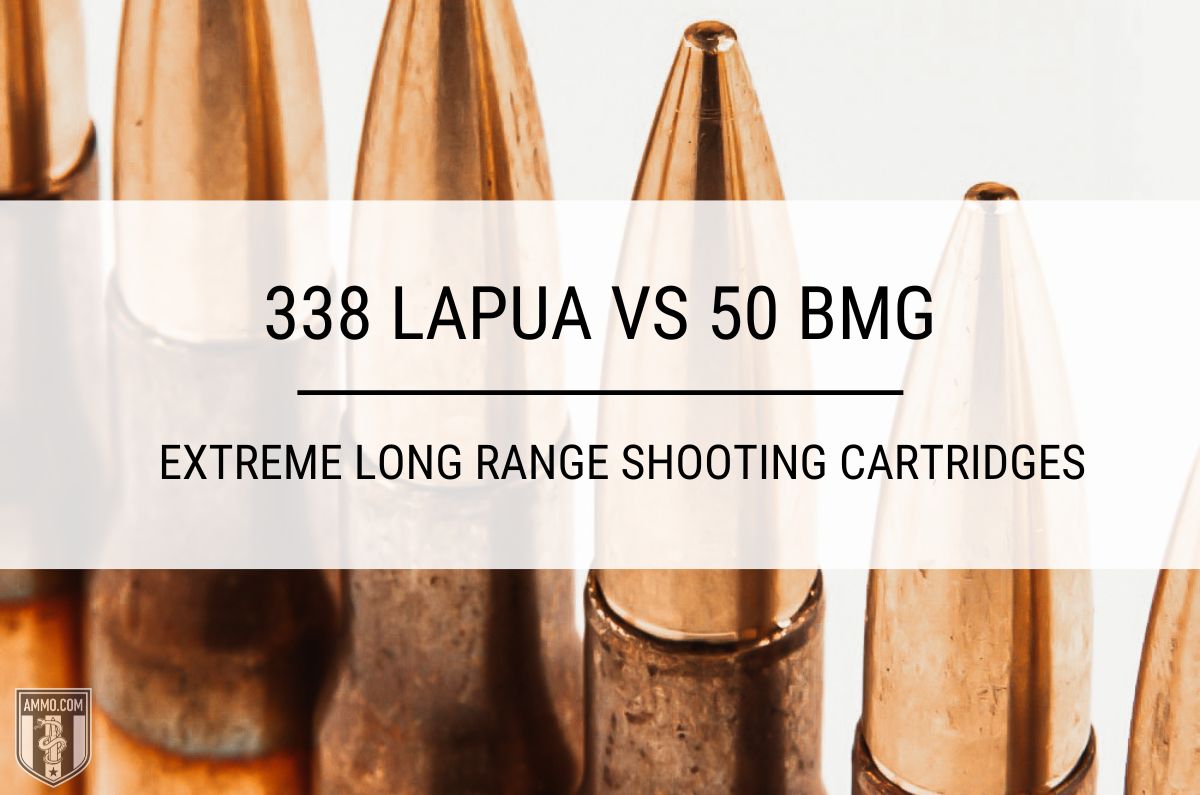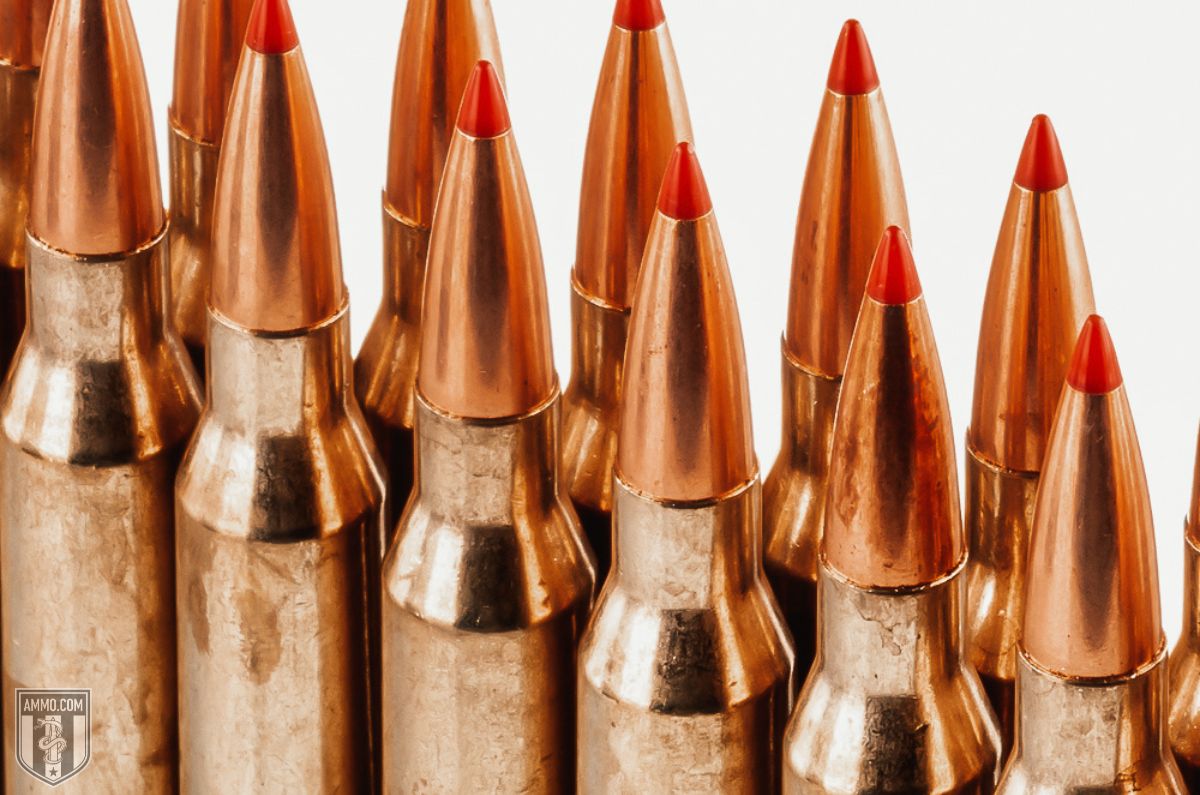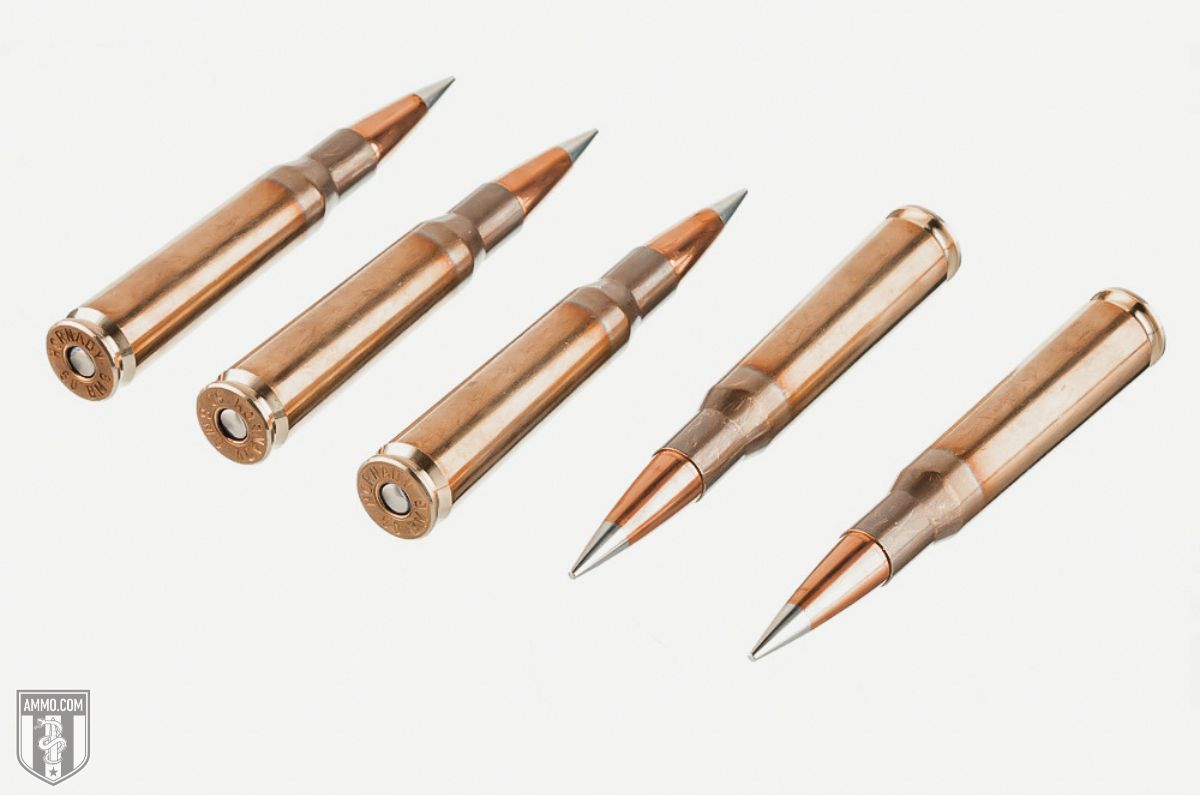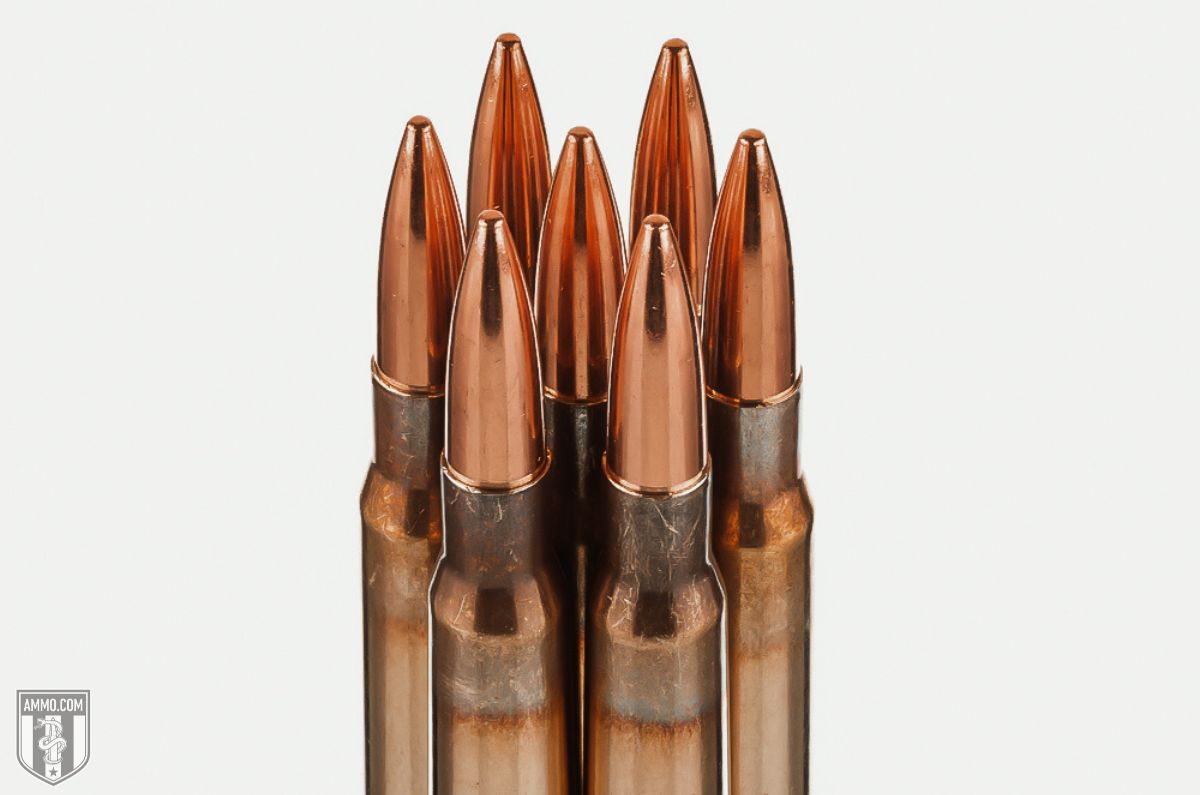338 Lapua vs 50 BMG: Extreme Long Range Shooting Cartridges

In this caliber comparison we are going to discuss two military rounds that take the concept of long distance shooting to a new level: the 338 Lapua Magnum and the 50 BMG.
The 50 Browning Machine Gun (50 Browning or 12.7x99mm NATO) is the longest serving centerfire cartridge in the US military while the 338 Lapua Magnum is a relative newcomer to the long range shooting scene.
Although initially developed for military use, the 338 Lapua Mag and 50 BMG have found a home with civilian shooters for long range hunting and F-class shooting competitions.
In this article, we will evaluate the 50 BMG vs 338 Lapua to help you understand the differences between the two and give you a clearer idea of which cartridge is best for your long range shooting needs.
What is the difference between 50 cal and 338 Lapua?
The difference between 50 BMG and 338 Lapua is that the 50 BMG is a bigger cartridge that fires a larger, heavier bullet with more kinetic energy than the 338 Lapua Magnum. Although the 338 Lapua has considerably less case capacity than the 50 BMG, both rounds have similar muzzle velocities.
Cartridge Specs
When evaluating centerfire cartridges, it’s a good idea to analyze the cartridge specs to gain more knowledge of each.
The 50 BMG was designed during World War I and officially adopted in 1921 while the 338 Lapua is youngster in comparison, as it was accepted as a military cartridge in 1989.
John Moses Browning designed the 50 BMG at the behest of the Army to provide them with a round that fired heavy projectiles at 2,700 fps. The goal of the round was to penetrate light armored personnel carriers and tanks of the era; however, it was quickly adopted for use in aircraft, for anti-air guns, as well as being mounted on tanks.

Browning produced two firearms for the military that are still in used today almost 100 years later. The M2, also known as the “Ma Deuce”, saw its first action in World War II and has been a staple US military machine gun ever since.
More recently the 50 BMG has been adopted for precision rifle use in the Barrett M82 and McMillan Tac-50 sniper rifles.
On the other hand, the 338 Lapua was designed to bridge the gap between the 300 Win Mag and the 50 BMG and offer military snipers an intermediate rifle cartridge capable of penetrating body armor at 1,000 yards.
Browning developed the 50 BMG case from scratch without a parent cartridge, although some historians argue if he drew inspiration from the German 13.2 mm TuF anti-tank round or the anemic French 11mm ammo of the day. On the other hand, the 338 Lapua was developed using an older hunting cartridge, the 416 Rigby, as a parent case.
Perhaps the most obvious difference between these two rounds is their size, as the 50 BMG towers over 33 Lapua Mag with a case length of 3.91” compared to 2.724”. The disparity only increases between the two with overall length, as the 50 BMG measures 5.45” while the 338 has a maximum overall length of 3.681”.
The 50 BMG also fires a considerably larger projectile with a bullet diameter of 0.51” compared to 0.338” for the Lapua Magnum.
Factory loads for civilians are typically loaded between 650 gr and 750 gr for 50 BMG while the 338 is generally loaded with bullet weights between 200 gr and 300 gr.
Those massive bullets require a lot of powder to propel them down the barrel and towards their intended target. As such, the case capacity of the 50 BMG is over double that of the 338 Lapua at 292.8 gr vs 114.2 gr.
However, all that case capacity and massive projectiles come at the cost of recoil.
Recoil
The 338 Lapua has considerably less recoil than the 50 BMG.
Recoil is an important consideration when purchasing a new rifle as a round with heavy recoil will be more difficult to control and will slow your rate of follow up shots.
Free Recoil is affected primarily by muzzle velocity (FPS), powder charge, bullet weight, and firearm weight.
When calculating free recoil for these two massive rounds, it is impossible to perform a pure “apples to apples” comparison as both cartridges use extremely different firearms. For 50 BMG we will consider the Barrett Model 82 semi-automatic sniper rifle weighing a whopping 32.7 pounds. In comparison, for the 338 Lapua we will utilize a McMillan Tac-338 bolt-action rifle weighing 13 pounds.
For ammo selection, we will consider standard military issue M33 ball for 50 BMG firing a 660 gr FMJ at 2,910 fps compared to the Lapua Lock Base 250 gr FMJ traveling at 2,952 fps for 338 Lapua Mag.
Given these rounds, the 338 Lapua will have a free recoil of 36.5 ft-lbs compared to 82.7 ft-lbs for the 50 BMG. The 50 BMG has more than double the free recoil of 338 Lapua Mag.
To put these massive recoil numbers in perspective, an average 308 Winchester load will have around 20 ft-lbs of free recoil.
The amount of recoil produced by the 338 and the 50 BMG is so excessive that virtually every rifle comes with a muzzle brake installed at the factory to help mitigate felt recoil. Without it, most shooters would not be able to handle the rifle accurately.
Although many professional shooters will tell you that the recoil is manageable, this comes from years of training and acclimatization to the considerable power that each round possess. Learning how to shoot these cartridges accurately takes time, as this amount of recoil can easily cause inexperienced shooters to develop a recoil flinch.
However, most shooters understand what they are getting into when they make the decision to purchase a 50 BMG rifle. Just understand that the 50 is a different beast entirely and it would be wise to consider professional training to learn how to handle the recoil of the mighty BMG round.
Muzzle Velocity, Kinetic Energy, and Trajectory
The 338 Lapua may have half the recoil, but how does it compare to 50 BMG ballistics?
For this comparison we will analyze two rounds for each cartridge. The 50 BMG rounds selected are the Hornady Match 750 gr A-MAX and the PMC Bronze 660 gr FMJ-BT. For the 338 Lapua Magnum, the Nosler 300 grain AccuBond and 250 gr Lapua Lock Base were selected.

All rounds will be zeroed at 100 yards and as these rounds are typically used for long range shooting, we will look at distances out to 1,500 yards.
The muzzle velocities of all four rounds are surprisingly similar given the massive difference in case capacity between the 338 and the 50. These numbers are considerably more impressive when you consider that the 50 BMG is firing approximately 2.5x heavier bullets than the 338 Lapua, even though some shooters would expect higher velocities out of the 50 BMG.
The 660 gr FMJ PMC round has the highest muzzle velocity at 3,080 fps followed closely by the Lapua 250 gr Lock Base at 2,952 fps. Approximately 400 fps separates all four rounds, which is impressive given the size difference between the 50 and 338.
Another surprising data point is how similar the trajectory of each round is out to 1,000 yards. Not unsurprisingly, the 50 BMG has a flatter trajectory overall with -226” and -239” of bullet drop for the 660 gr and 750 gr factory loads, respectively. The 338 Lapua rounds experienced -264” and -316” of bullet drop for the 250 gr and 300 gr offerings.
However, as the rounds continue to go further downrange, the rounds begin to separate, and the flatter trajectory of the 50 BMG becomes more apparent. At 1,500 yards the two 50 rounds are extremely close to each other with -673” and -651” of bullet drop for the 660 gr and 750 gr loads, respectively. However, the 338 Lapua bullets have experienced considerably more bullet drop at -817” and -938” for the 250 gr and 300 gr rounds.
At these extreme ranges, the 338 Lapua is about to break below the sound barrier (1,125 fps) while the 50 BMG is still comfortably above supersonic velocities by +200 fps or more. Bullet trajectories typically suffer when approaching subsonic velocities as gravity will affect the round more significantly.
However, if there’s one thing that the 50 BMG is known for, it must be its ridiculous amount of kinetic energy. The 50 absolutely dominates the 338 in terms of muzzle energy with a nearly 2.5-fold difference between the two.
Both 50 BMG rounds leave the muzzle with over 13,000 ft-lbs of kinetic energy compared to about 4,700 ft-lbs for the 338. To put this into perspective, the 750 gr A-MAX load has essentially the same kinetic energy at 1,500 yards as a 300 Winchester Magnum has at the muzzle.
This is not to say that the 338 Lapua is lacking in kinetic energy, as the round is considerably more efficient at conserving its energy over distance than the 50. However, the 338 is simply outclassed by the 50 in terms of kinetic energy at all ranges.
Ballistic Coefficient and Sectional Density
Ballistic coefficient (BC) is a measure of how aerodynamic a bullet is and how well it will resist wind drift. Sectional density (SD) is a way to evaluate the penetration ability of a bullet based on its external dimensions, design, and weight.
The 50 BMG has some of the highest BC values of all centerfire rifle cartridges, with heavier rounds having a BC over 1.0. For rounds evaluated in the previous section, the 750 gr A-MAX bullet has a BC of 1.05 while the 660 gr PMC factory ammo has a BC of 0.701. In comparison, the 338 Lapua loads have a BC of 0.625 and 0.72 for the 250 gr and 300 gr loads, respectively.
For sectional density, typically smaller diameter bullets have an advantage as they can focus all their muzzle energy onto a more localized area. However, the 50 BMG packs so much kinetic energy it will often have a higher SD than then 338 Lapua.
For example, the 50 BMG 750 gr A-MAX bullet has a sectional density of 0.412 while the 660 gr FMJ has a SD of 0.357. In contrast, the 300 gr Accubond bullet for 338 Lapua has a sectional density of 0.375, falling right in the middle of the two 50 cal rounds.
Hunting
The 338 Lapua and 50 BMG reaffirmed their long range shooting capabilities during the wars in Iraq and Afghanistan, however their use for big game hunting is a relatively new development.
There’s no question that 50 BMG ballistics are impressive and there is no animal on the planet that can stand up to it, however the 50 cal has several downsides when it comes to hunting.
The first major issue using the 50 for hunting is rifle weight. Most hunters would shy away from carrying a 30-pound rifle into the woods as 50 cal rifles are large, clunky, and difficult to maneuver in tight spaces. If you plan on carrying a Barrett into the woods, you better hit the gym because you’ll need to be in excellent shape.
Although the rifle weight is an issue for long hikes, it is needed to curtail the punishing recoil the 50 BMG imparts upon shooters’ shoulders. Heavy recoil can lead to shooters developing a flinch which can negatively affect accuracy.
Some hunters criticize the use of a 50 BMG for hunting large game due to the lack of expanding bullets available for the cartridge. This is somewhat of a moot point as a 0.51” diameter bullet will leave more than a large enough wound channel, let alone the insane amount of kinetic energy that will be dumped into the target.
On the other hand, using the 338 Lapua for big game hunting is a trend that is starting to pick up steam with the release of different hunting rounds from manufactures like Nosler, Berger, Browning, and Federal.
A long range rifle chambered in 338 Lapua would make an excellent choice for hunting large game like elk or moose and it allows hunters to engage dangerous game like grizzly bears at standoff distances.
Although you can find plenty of YouTube videos of shooters hunting animals like feral hogs with 50 BMG, the 338 Lapua makes the better choice for big game hunting due to its lower recoil, lighter rifles, and ever-growing hunting ammo selection.
Ammo and Rifle Cost/Availability
Shooting either of these cartridges is a massive financial investment, as ammo and rifles are very expensive for both 338 and 50.
In terms of ammo availability, the 338 Lapua has considerably more varieties of ammo available. Most 50 BMG ammo is either FMJ or match grade specifically designed for long distance target shooting, while the 338 enjoys multiple big game hunting and target load options.
Inexpensive is not a word often used in conjunction with the 338 and 50, however 50 cal FMJ ammo can be had for around $3/round while match grade ammo typically runs in the range of $7-10/round. Full metal jacket 338 practice ammo generally starts around $4/round while premium hunting or target loads like the Remington 250 gr Scenar Match can be had for around $7-9/round.
Special care should be taken when purchasing military surplus ammo for 50 BMG from private individuals or at gun shows.
One famous incident occurred when a YouTube personality known as Kentucky Ballistics suffered near fatal injuries when he fired, what he thought, was a surplus 50 BMG SLAP round out of his Serbu rifle. The round had most likely been tampered with and was loaded to pressures that destroyed his rifle and nearly cost him his life.
Thankfully he survived and was able to recreate the incident using ballistic gel to show what happened. You can watch the full video here.
For rifles, the 338 Lapua Magnum has more options available that can be had at lower prices than a 50 BMG.
The 338 Lapua has been gaining momentum as a long range rifle for F-class competitions, and as such manufactures are beginning to offer more options to the average consumer. In the past, 338 rifles like the FN Ballista or Barrett MRAD would fetch a price tag well north of $4,000. However, other manufacturers began offering lower cost competition rifles like the Ruger Precision Rifle or the Savage 10BA that can be had for around half the price of a Barrett.
If you want a rifle chambered in 50 BMG, it goes without saying that you’re going to need to drop a lot of coin on it. One of the least expensive 50 cal options on the market is the Serbu RN-50, which is a single shot rifle that can be had for under $2,000 (if you can find one).
Rifles for 50 BMG can be had in both semi-automatic and bolt-action. A high-quality rifle such as a Barrett M82, McMillan Tac-50, Desert Tech HTI, or Accuracy International AX50 will easily cost $7,000 or more.
Reloading
Reloading is one method shooters use to reduce their overall cost per round and increase the consistency of their ammo to sub-MOA levels. Furthermore, handloads can be tailored to your rifle to meet your specific shooting needs.
Most shooters who take on either of these magnum cartridges will handload their own ammo to help keep costs lower. Furthermore, long range precision shooting requires the utmost levels of ammo consistency, as minor variations in muzzle velocity are magnified at longer distances.
Most all reloading presses can handle the 338 Lapua, however specialized presses and dies are needed to reload 50 BMG.
Special care needs to be taken when reloading the 50 BMG, as the amount of powder needed for each round is substantial and it would be easy to overcharge the round.
While there are well over a dozen different powders appropriate for reloading 338 Lapua, your choices for 50 BMG are considerably more limited. The most popular 50-cal reloading powders are Vihtavuori 24N41, SW 50BMG, US 869, and Hodgdon 50BMG.
It is also advisable to purchase these powders (if you can find them) in bulk, as a moderate 225 grain powder charge will chew through a pound of powder in 31 reloads.
The 338 Lapua will also eat through powder incredibly quickly, but less so than the 50.
Bullets for the 338 Lapua will be easier to come by and less expensive than 50-cal bullets, as the 0.338” diameter bullets are also fired by cartridges like the 338 Winchester Magnum, 340 Weatherby Mag, 338 Remington Ultra Magnum, and 338 Ruger Compact Mag. On the other hand, 0.51” diameter bullets are exclusively fired from the 50 BMG.
Final Shots: 50 BMG vs 338 Lapua Magnum
The 338 Lapua Magnum and the 50 BMG are two heavy hitting NATO rounds that have proven their capabilities on the battlefield time and time again.
The 50 Browning Machine Gun is used by militaries across the globe to this day, playing a key role in World War II all the way through the War on Terror and in current military operations. It currently holds 7 out of the top 10 longest confirmed sniper shots in history and has an effective range of nearly 2 miles.
The 338 Lapua Magnum is an intermediate cartridge meant to bridge the gap between the 300 Win Mag and the 50 BMG. Capable of punching through hard body armor at 1,000 yards, the 338 Lapua offers shooters a long range hunting and target shooting cartridge with a flat trajectory and excellent terminal ballistics.
Although 50 BMG is the more powerful cartridge by far, most shooters will opt for the 338 Lapua as it is less expensive and there are more rifle/ammo options available for it.
No matter which cartridge you choose, make sure you stock up on ammunition here at Ammo.com and I’ll see you on the range!
Ammo Comparisons
- .308 vs 5.56
- 6.5 Creedmoor vs .308
- .300 Blackout vs .308
- .300 Win Mag vs .308
- .243 vs .308
- .308 vs .30-06
- 7mm-08 vs .308
- .270 vs .308
- 7.62x39 vs .308
- .223 vs .308
- .338 Lapua vs .308
- .380 ACP vs 9mm
- .223 vs 5.56
- .300 Blackout vs 5.56
- 9mm vs 45 ACP
- 9mm vs 40 S&W
- .357 SIG vs 9mm
- 10mm vs 9mm
- 9mm vs 9mm Luger
- .243 vs .270
- .300 Win Mag vs .30-06
- .270 vs .30-06
- .40 vs .45
- 38 Special vs 357
- 9mm vs 40 vs 45
- 5.56 vs 7.62x39
- 338 Lapua vs .30-06
- .30-30 vs .30-06
- 300 PRC vs 338 Lapua
- .30-06 vs 7mm
- 300 Win Mag vs 338 Lapua
- 300 PRC vs 300 Win Mag
- 300 WSM vs 300 Win Mag
- 338 Win Mag vs 338 Lapua
- 12 Gauge vs 20 Gauge
- 10mm vs 357 Mag
- .30-30 vs 7.62x39
- 224 Valkyrie vs 22-250
- 17 HMR vs 22 Mag
- 7.62x39 vs .300 Blackout
- 45 ACP vs 45 Auto
- 45-70 vs 30-30
- 300 Blackout vs 223
- 357 Magnum vs 9mm
- 350 Legend vs 300 Blackout
- 224 Valkyrie vs 223
- 45 ACP vs 38 Super
- 6.5 Grendel vs .308
- 17 HMR vs 22 LR
- 10 Gauge vs 12 Gauge
- 22-250 vs 223
- 45 Colt vs 45 ACP
- 350 Legend vs 30-30
- 5.7x28 vs 223
- 5.7 vs 9mm
- 5.56 vs 5.7
- 22 vs 9mm
- Buckshot vs Birdshot
- 450 Bushmaster vs 308
- 450 Bushmaster vs 223
- Buckshot vs Slug
- 6.5 Grendel vs 5.56 vs 223
- 6mm ARC vs 6.5 Grendel
- 44 vs 45
- 458 SOCOM vs 5.56
- 357 vs 44
- 32 ACP vs 380
- 300 Win Mag vs 338 Win Mag vs 338 Lapua Mag
- 450 Bushmaster vs 458 SOCOM vs 50 Beowulf
- 6mm Creedmoor vs 6.5 Creedmoor
- TMJ vs FMJ
- 44 Special Vs 44 Magnum
- 45 90 vs 45 70
- 6.8 Western vs 6.8 SPC
- 50 Beowulf vs 50 BMG
- 26 Nosler vs 6.5 PRC
- 28 Gauge vs 410
- 6.8 SPC vs 5.56
- 6.8 SPC vs 6.5 Grendel
- 6.8 Western vs 7mm Rem Mag vs .28 Nosler
- 6.8 Western vs 6.5 Creedmoor
- 22 Hornet vs 223
- 6.8 Western vs 6.5 PRC
- .410 vs 12 Gauge
- .410 vs 20 Gauge
- 22 LR vs 22 Mag
- 6mm ARC vs 243
- 7mm-08 vs 270
- 243 vs 6.5 Creedmoor
- Nickel vs Brass Casing
- 204 Ruger vs 223
- 50 Beowulf vs 5.56
- 260 Remington vs 6.5 Creedmoor
- 6mm Remington vs 243
- 28 Nosler vs 300 PRC
- 50 Beowulf vs 50 AE
- 22 Nosler vs 22-250
- 450 Marlin vs 45-70
- 300 Win Mag vs 300 Norma
- 458 SOCOM vs 300 Blackout
- 38-55 vs 45-70
- 22 Hornet vs 22 LR
- 300 Norma vs 338 Lapua
- 338 Lapua vs 50 BMG
- 28 Nosler vs 300 Win Mag
- 28 Nosler vs 6.5 Creedmoor
- 204 vs 22-250
- 458 SOCOM vs 45 70
- 44 40 vs 45 70
- 6.8 SPC vs 6.5 Creedmoor
- 450 Bushmaster vs 30-06
- 7mm Rem Mag vs 300 Win Mag
- 30 Carbine vs 223
- 25-06 vs 30-06
- 26 Nosler vs 28 Nosler
- 16ga vs 12ga
- 30 06 vs 7.62 x54R
- 9mm Makarov vs 9mm Luger
- 350 Legend vs 223
- 30 Carbine vs 5.56
- 6.5x55 vs 6.5 Creedmoor
- 6.5 Creedmoor vs 270 vs 25-06
- M193 vs M855
- 450 Bushmaster vs 458 SOCOM
- 6.5 Grendel vs 6.5 Creedmoor
- 350 Legend vs 5.56
- .277 Fury vs 6.8 SPC
- 277 Fury vs 300 Win Mag
- 10mm vs .45 ACP
- 277 Fury vs 223
- 6.8 SPC vs 300 Blackout
- 6.5 PRC vs 6.5 Creedmoor
- 277 Fury vs 308
- 277 Fury vs 6.5 Creedmoor
- 350 Legend vs 450 Bushmaster
- 277 Fury Vs 5.56 NATO
- 10mm vs 40S&W
- 32 ACP vs 9mm
- 32 Special vs 9mm
- 8.6 Blackout vs 300 Blackout
- 30 Super Carry vs. 9mm
- 5.56 vs 9mm
- .50 Action Express vs 9mm
- 7.62x25 vs. 9mm
- 10mm vs 44 Magnum
- 300 Blackout vs 300 Win Mag
- 6.5 Grendel vs 300 Blackout
- 460 Rowland vs 10mm
- 300 RUM vs 300 PRC
- 300 Norma vs 300 PRC
- 45 GAP vs 45 ACP
- 7mm PRC vs 300 Win Mag
- 300 PRC vs 6.5 Creedmoor
- 300 PRC vs 308
- 357 SIG vs 357 Mag
- 7.62x39 vs 7.62x51
- 243 Win vs 223 Rem
- 30 Nosler vs 300 PRC
- 6.5 Creedmoor vs. 30-06 Springfield
- 450 S&W vs. 44 Magnum
- 6.5 Creedmoor vs. 300 Win Mag
- 454 Cassull vs. 45-70 Govt
- 454 Cassull vs. 44 Mag
- 7.62x54r vs. 308 Winchester
- 22 ARC vs. 223 Rem
- Subsonic vs. Supersonic Ammo









